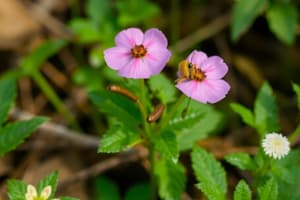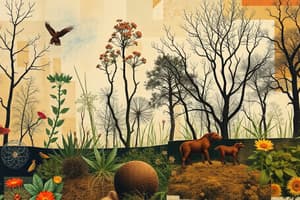Podcast
Questions and Answers
Which of the following is an example of an abiotic factor?
Which of the following is an example of an abiotic factor?
- The total biomass of a forest
- A community of decomposers
- A population of herbivores
- The amount of sunlight in an ecosystem (correct)
How does chemosynthesis differ from photosynthesis?
How does chemosynthesis differ from photosynthesis?
- Chemosynthesis occurs in all organisms, while photosynthesis only occurs in plants.
- Chemosynthesis uses chemical energy to produce carbohydrates, while photosynthesis uses sunlight. (correct)
- Chemosynthesis produces carbohydrates, while photosynthesis breaks them down.
- Chemosynthesis uses sunlight, while photosynthesis uses chemical energy.
What is the relationship between a community and a population?
What is the relationship between a community and a population?
- A community and a population are the same thing.
- A community is a group of individuals of the same species, while a population is an assemblage of different species.
- A population includes the abiotic factors, while a community only includes biotic factors.
- A community is an assemblage of different populations living together in a defined area. (correct)
Which of the following best describes the role of a decomposer in an ecosystem?
Which of the following best describes the role of a decomposer in an ecosystem?
What is the primary function of denitrification in the nitrogen cycle?
What is the primary function of denitrification in the nitrogen cycle?
How do detritivores obtain their energy?
How do detritivores obtain their energy?
What does an ecological pyramid illustrate?
What does an ecological pyramid illustrate?
What is the main focus of the scientific study of ecology?
What is the main focus of the scientific study of ecology?
How is an ecosystem different from a biosphere?
How is an ecosystem different from a biosphere?
Which of these describes the flow of energy through a food chain?
Which of these describes the flow of energy through a food chain?
What is a key characteristic of a herbivore?
What is a key characteristic of a herbivore?
How do heterotrophs obtain food?
How do heterotrophs obtain food?
What is the role of nitrogen fixation in an ecosystem?
What is the role of nitrogen fixation in an ecosystem?
Why is a nutrient essential for an organism?
Why is a nutrient essential for an organism?
What is the role of primary producers in an ecosystem?
What is the role of primary producers in an ecosystem?
Where are phytoplankton typically found?
Where are phytoplankton typically found?
What defines a population in ecological terms?
What defines a population in ecological terms?
What role does a scavenger play in an ecosystem?
What role does a scavenger play in an ecosystem?
What does each trophic level represent?
What does each trophic level represent?
What is the primary characteristic of zooplankton?
What is the primary characteristic of zooplankton?
Flashcards
Abiotic Factor
Abiotic Factor
Any physical, non-living compound of an ecosystem.
Autotroph
Autotroph
Organism able to capture energy from sunlight or chemicals to produce its food; also called a primary producer.
Biomass
Biomass
Total amount of living tissue within a given trophic level.
Biosphere
Biosphere
Signup and view all the flashcards
Biotic Factor
Biotic Factor
Signup and view all the flashcards
Carnivore
Carnivore
Signup and view all the flashcards
Chemosynthesis
Chemosynthesis
Signup and view all the flashcards
Community
Community
Signup and view all the flashcards
Consumer
Consumer
Signup and view all the flashcards
Decomposer
Decomposer
Signup and view all the flashcards
Denitrification
Denitrification
Signup and view all the flashcards
Detrivore
Detrivore
Signup and view all the flashcards
Ecological Pyramid
Ecological Pyramid
Signup and view all the flashcards
Ecology
Ecology
Signup and view all the flashcards
Ecosystem
Ecosystem
Signup and view all the flashcards
Food Chain
Food Chain
Signup and view all the flashcards
Herbivore
Herbivore
Signup and view all the flashcards
Heterotroph
Heterotroph
Signup and view all the flashcards
Nitrogen fixation
Nitrogen fixation
Signup and view all the flashcards
Nutrient
Nutrient
Signup and view all the flashcards
Photosynthesis
Photosynthesis
Signup and view all the flashcards
Primary Producer
Primary Producer
Signup and view all the flashcards
Phytoplankton
Phytoplankton
Signup and view all the flashcards
Population
Population
Signup and view all the flashcards
Scavenger
Scavenger
Signup and view all the flashcards
Trophic Level
Trophic Level
Signup and view all the flashcards
Zooplankton
Zooplankton
Signup and view all the flashcards
Study Notes
- BIO-Ecology is an introduction to ecology glossary
Vocabulary
- Abiotic factors are any physical, non-living compounds of an ecosystem that affect organisms
- Autotrophs capture energy from sunlight or chemicals to create their own food from inorganic compounds; also called primary producers
- Biomass is the total amount of living tissue within a given trophic level
- Biosphere is the part of planet Earth where life exists, including land, water, and air
- Biotic factors are the living parts of the environment with which an organism might interact
- Carnivores are organisms that obtain energy by eating animals
- Chemosynthesis is a process where chemical energy is used to produce carbohydrates
- A community is an assemblage of different populations that live together in a defined area
- A consumer is an organism that relies on eating other organisms for energy and food; they are heterotrophic
- Decomposers break down and obtain energy from dead organic matter (e.g., fungi and bacteria), but don't eat matter chemically
- Denitrification is the process by which nitrogen held in dead organic matter is converted into nitrogen gas that is released into the atmosphere
- Detritivores are organisms that feed on small plant and animal remains and other dead matter (i.e., feed on detritus)
- Ecological pyramids illustrate the relative amounts of energy or matter contained within each trophic level
- Ecology is the scientific study of interactions among organisms and between organisms and their environment
- An ecosystem includes all the organisms that live in a place, together with their nonliving environment.
- A food chain describes the series of steps in an ecosystem in which organisms transfer energy by eating and being eaten
- A herbivore is an animal that solely consumes plants
- Heterotrophs obtain food by consuming other living things, also called consumers
- Nitrogen fixation converts nitrogen gas into nitrogen compounds usable by plants
- A nutrient is a chemical substance that organisms need to sustain life
- Photosynthesis uses light for plants to gain energy and sustain life
- The formula for photosynthesis is carbon dioxide + water yields glucose + oxygen
- Primary producers are the first producers of energy-rich compounds used by other organisms
- Phytoplankton are photosynthetic algae found near the surface of the ocean
- A population represents groups of individuals of the same species that live in the same area
- A scavenger is an animal that mostly consumes decaying biomass, such as meat or rotting material
- A trophic level is each step in a food chain or food web
- Zooplankton are small floating or weakly swimming organisms that drift with water currents, often with phytoplankton
- The formula for cellular respiration is glucose + oxygen yields carbon dioxide + water + energy stored in ATP
Studying That Suits You
Use AI to generate personalized quizzes and flashcards to suit your learning preferences.




